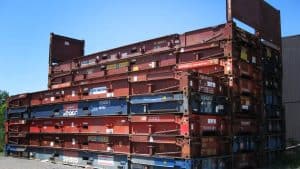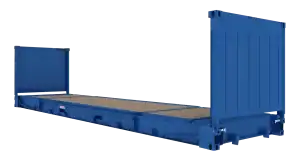Special cargo containers are generally referred to as special containers, classified into several types:
- Reefer Containers (Refrigerated Containers)
- Dress Hanger Containers
- Open Top Containers
- Flat Rack Containers (FR)
- Tank Containers
Today, let’s dive into Flat Rack Containers (FR):
What is a Flat Rack Container?
A Flat Rack Container, abbreviated as FR, is a specialized container derived from a standard container by removing its roof and side walls. In some cases, even the end walls are removed, leaving only the base and corner posts. This unique structure plays a vital role in transporting oversized cargo. In simple terms, it is a container without a roof and side walls, making it particularly suitable for loading and unloading from the sides.
Cargo Suitable for Flat Rack Containers
Flat Rack Containers are primarily used for:
- Oversized, overlength, overwidth, or overweight cargo, such as large machinery and heavy equipment.
- Livestock and unpackaged goods like steel that do not require external packaging.
- Oversized items that are extremely wide or tall, which can be easily lifted and loaded.
Key Features of Flat Rack Containers
- Thicker Base: The bottom panel is generally about 60 cm thick, making it capable of carrying heavier loads.
- Open Design: Without a roof or side walls, it can accommodate oversized and overwidth cargo (typically not exceeding 4 meters).
- Non-Waterproof: Flat racks are not sealed or waterproof, so they cannot carry goods sensitive to moisture.
- Ease of Loading/Unloading: The design allows for convenient handling of irregularly shaped items.
- Reinforcement Options: Equipped with lashing rings on the side beams, corner posts, and bottom panel to secure cargo effectively.
Types and Variants
Flat Rack Containers typically come in two sizes:
- 20′ FR
- 40′ FR
They can also be categorized into pillar-type flat racks and board-type flat racks. When the pillars and end boards are laid flat, the container can transform into a flatbed. This dual functionality aligns with the English abbreviation FR, meaning “Flat Rack” or “Flatbed.”
Market and Operational Considerations
- Limited Availability: Special containers, including flat racks, are less common in the market, with lower demand compared to standard containers.
- Operational Complexity: Managing special containers involves more complicated processes. Confirmations are required at multiple stages, including container availability, pricing, and space booking, before acceptance.
- Pricing Variability: Prices for flat rack containers vary significantly and are not easily comparable. Many shipping companies do not offer flat rack services.
- High-Value Cargo: Goods transported in special containers are usually of higher value.
Weight Standards and Regulations
The International Standards Organization (ISO) has specific guidelines for heavy containers:
- Containers with a Maximum Gross Weight (MGW) exceeding 30,480 kg (30.48 tons) are classified as heavy containers. These require a triangular “Overweight” label on the container door.
- Containers weighing less than 30,480 kg are considered standard containers and do not require the label.
Shipping companies may have their own weight standards, which can vary. For example:
- A 20GP container is considered “heavy” if it exceeds 21 tons. If the cargo weighs 23 tons, the shipper may need to pay a surcharge for overweight or heavy containers, depending on the shipping company’s policies.
Exceptions
Not all heavy containers incur additional charges. Some shipping companies may allow free “overweight container” applications. However, approval depends on their policies.
Practical Tips
To efficiently handle flat rack container shipments, it’s essential to:
- Understand the shipping market’s capacity and pricing methods.
- Obtain detailed cargo parameters (photos are helpful), shipment schedules, and delivery timelines.
- Accurately estimate operational challenges and calculate all associated costs.
Growing Importance of Flat Rack Containers
As global economic trade continues to grow and the modern logistics market rapidly develops, Flat Rack Containers (FR) have become increasingly essential. Their unparalleled flexibility makes them a key player in the thriving containerized logistics industry.
With their unique characteristics and operational advantages, flat racks are expected to play an even greater role in the transportation of oversized cargo, supporting the ever-expanding demands of global trade.



